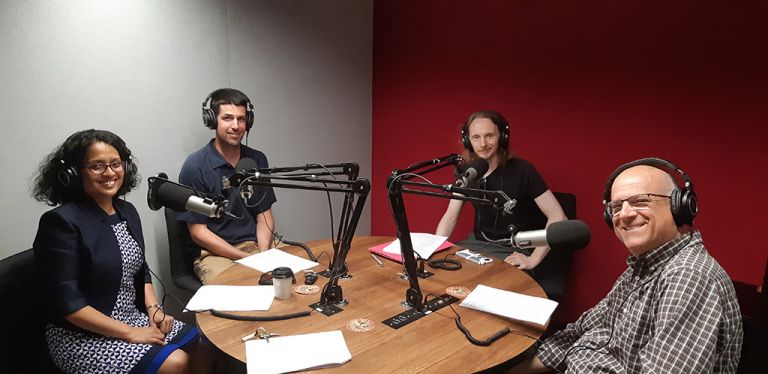
ep13-podcast.jpg
Episode 13 (left to right) - Dr Sevvandi Kandanaarachchi, Dr Shannon Ryan, Dr Anthony Mays, Prof William Schonberg
Space junk and micrometeoroids present serious problems for any satellite or ship that ventures into earth's orbit. While we don't yet have graviton-based deflector shields like in Star Trek, there are some shield technologies that we use today to protect the craft.
In Episode 12 (Part 1 of this 2 part series), ACEMS Associate Investigators Dr Sevvandi Kandanaarachchi (Monash Univ) and Dr Anthony Mays (The University of Melbourne) talk about the problem of space junk and some statistical models that are used to predict the effectiveness of a shield. In particular, Sevvandi and co-authors have employed a machine-learning technique, called a Support Vector Machine (SVM), to analyse data on ballistic collisions and predict whether a shield will fail or not. (see Episode 12 link below)
In Episode 13 (Part 2), Sevvandi and Anthony continue their discussion about protecting spacecraft with two special guests:
- Dr Shannon Ryan - Australian Defense Science & Technology Group (DST Group)
- Prof William Schonberg - Missouri (USA) University of Science & Technology
(**Note - there are two versions of Episode 13: a standard-length version, and a long version with the entire conversation. Links for both are on this page)
Subscribe and listen to the podcast for free on iTunes, in Spotify, or on your Android device.
Extended Version of Episode 13 (Part 2):
More information about our guests Episode 13 (Part 2)
Dr Shannon Ryan is a Discipline Leader in Land Vehicle Survivability at Defence Science and Technology Group, responsible for armour protection against ballistic threats. He is also an Adjunct Associate Professor at UNSW Canberra’s School of Engineering and Information Technology. Shannon’s previous research work dealt with spacecraft protection against micrometeoroids and orbital debris, including positions at NASA’s Johnson Space Center and the Fraunhofer Ernst Mach Institute in Germany. Shannon is also one of Sevvandi's co-authors, where they investigated the application of machine learning techniques to analyze hypervelocity impacts.
- Shannon's staff page at DST Group: https://www.dst.defence.gov.au/staff/dr-shannon-ryan
- The Hypervelocity Impact Technology research group that Shannon previously worked for: https://hvit.jsc.nasa.gov/
- Shannon's paper discussing a new analytic model for Whipple shield impacts: Miller, J.E, Bjorkman, M.D., Christiansen, E.L. & Ryan, S.J. (2015), ``Analytic Ballistic Performance Model of Whipple Shields'', Procedia Engineering 103, pp. 389 – 397.
Professor William Schonberg hails from the Missouri University of Science and Technology in the United States. Since the 1980s, he has been researching topics in shock physics, spacecraft protection, hypervelocity impact, and penetration mechanics. His results have been applied to protecting spacecraft in low earth orbit, designing lunar habitats, and other fields. Bill has worked with: NASA at the Marshall Space Flight Centre and the Jet Propulsion Laboratory; the US Air Force at Wright Laboratories; and, as a Humboldt Research Award recipient, at the Fraunhofer Ernst Mach Institute, in Freiburg, Germany. He has received a long list of awards over his career, including the Distinguished Scientist Award from the Hypervelocity Impact Society in 2015. Bill is currently visiting Australia as a Fulbright Distinguished Chair and Visiting Professor at RMIT.
- Bill's university webpage: https://people.mst.edu/faculty/wschon/
- Bill's review paper on the state of the research on spacecraft protection from debris and particles: Schonberg, William P. (2017), ``Studies of hypervelocity impact phenomena as applied to the protection of spacecraft operating in the MMOD environment'', Procedia Engineering 204, pp. 4–42.
Useful references and links:
Shannon and Sevvandi's papers:
- S. Ryan, S.K. & K. Smith-Miles (2015), "Support Vector Machines for Characterising Whipple Shield Performance", Procedia Engineering, 103, p.522 -- 529.
- S. Ryan, S. Thaler & S.K. (2016), "Machine learning methods for predicting the outcome of hypervelocity impact events", Expert SystemsWith Applications, 45, p. 23 --29.
Fred Whipple's original paper where he suggests the design of the shield:
A NASA Technical Report analysing the recorded impacts on the space shuttles' windscreens:
An article on Discover Magazine's blog has a great video of a Whipple shield impact.
Information about the number of satellites in orbit.
A description from NASA about the scale of the problem posed by space junk.
A statistical analysis of the likelihood of asteroid impacts destroying a ship.


